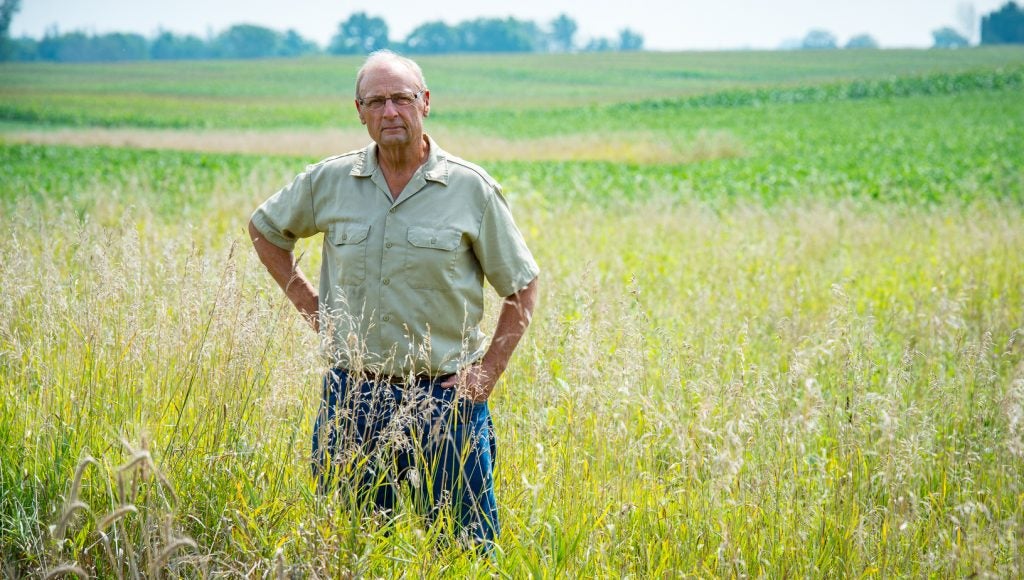Change in weather shifts Iowa farmer’s approach, saving money and time
This blog is authored by Bethany Baratta, senior writer at Iowa Soybean Association. It originally posted on the Iowa Soybean Association Newsroom.
Wayne Fredericks and his wife Ruth began farming in northern Iowa in the early 1970s. For the first 19 years of their farming careers, their farm was managed conventionally: corn stalks were plowed and soybean stubble was tilled before planting.

It was a change in the weather that altered their conventional farming practices — for the better.
Early freeze hooks farmer on no-till
“In the winter of 1991, we had an early freeze and I didn’t get any of our fall plowing done,” Wayne recalls. “I sat in my office in December wondering what the heck I was going to do.”
Wayne stumbled upon an article about a farmer no-tilling soybeans. Wayne was intrigued. Later, a discussion with his John Deere implement dealer turned into a proposition. The dealer was going to get a no-till drill to run a trial, and he would lend it to Wayne if he was interested.
The result: good growth and weed control, with outstanding yields.
“I was hooked,” Wayne says. “I went fully from plowing to no-till soybeans in one fell swoop.”
Even though Wayne was initially wary of no-till, he has found a way to optimize the economics of his corn fields using a strip-till system. He applies phosphorous and potassium in the fall in those strips with the goal of getting good residue cover. In the spring, he no-tills into those fall-built strips. He’s found the strips more suitable for planting; 7 to 10 degrees warmer and drier. It works well in his system, especially since he’s operating without additional labor.
Cover crops “make a significant difference” during floods
When Wayne made the decision to implement cover crops, his motivation was improving water quality, not economics. Over time however, he found that combining cover crops with no-till generated substantial financial value to his operation.
Iowa farmer Wayne Fredericks finds that conservation practices save him upwards of $100 per acre and reduce production risks from bad weather. Share on XIn 2008, Iowa experienced record flooding. Water inundated farms, flowed off agricultural fields and flooded communities downstream.
“The practices that we as farmers engage in on the land can make a significant difference to the communities downstream, not only in quality of water, but the quantity of water,” Wayne says. “This is huge to those downstream communities if we can make our landscape more like a sponge and soak up more of this water and help prevent some of this flooding.”
Wayne first got involved with cover crops through trials run by the Iowa Soybean Association. The trials aimed to learn what species worked well on his farm. Partaking in these trials heightened Wayne’s awareness of cover crops and the benefits they have for water quality — including meeting Iowa’s nutrient reduction goals.
After implementing cover crops into his system in 2016, Wayne saw a vast improvement in nitrate levels.
“I planted into the tall green cereal rye, and our tiles tested at 4.17 mg/liter, a 70% reduction in nitrogen,” Wayne says. “I was starting to get excited when I saw results like that.”
A close look at Wayne’s economics
Along his conservation journey, Wayne has found that reduced tillage practices and cover crops have improved soil structure and increased organic matter in his fields while reducing soil loss and fertilizer input costs.
A series of analyses show cost advantages in several areas of Wayne’s operation, including equipment and labor cost savings, lower fertilizer costs, improved weed control and reduced soil loss. The partial budget table below shows the costs and savings associated with Wayne’s transition to reduced tillage and cover crops:

The table shows that Wayne saves $44 per acre on equipment costs and $27 per acre on labor costs. Weed control provided by the cover crops saves Wayne $11 per acre on herbicide.
Wayne’s transition to conservation practices has also provided financial benefits through increased soil organic matter content.
Studies in cooperation with Jerry Hatfield, the former director of the National Laboratory for Agriculture and the Environment, have shown a 2.5% increase in soil organic matter from 1990 to 2015. Estimates through Natural Resources Conservation Service show that a 1% increase in organic matter generates, on average, $18 per acre in moisture retention and $11 per acre in mineralized nitrogen and phosphorous (represented in the table as fertilizer cost savings).
Wayne also receives $5 per acre from the Iowa Department of Ag and Land Stewardship for implementing of cover crops.*
Importantly, Wayne finds that his production is at lower risk from poor weather conditions, which has led him to reduce his crop insurance coverage from 85% to 70% and to switch his plans, saving $6.75 on corn acres.
Considering these factors and subtracting $21 per acre in cover crop costs leaves a net savings of $103.75 per acre through conservation.
“Maybe it’s hard in the beginning to point out the profitability associated with cover crops,” Wayne says, but he has found that the long-term benefits of improved efficiencies and soil health make conservation profitable. “It’s the right thing to do.”
*Wayne no longer qualifies for federal cost-share for his practices due to time/year commitments on payments.
Contact Bethany Baratta at bbaratta@iasoybeans.com.












